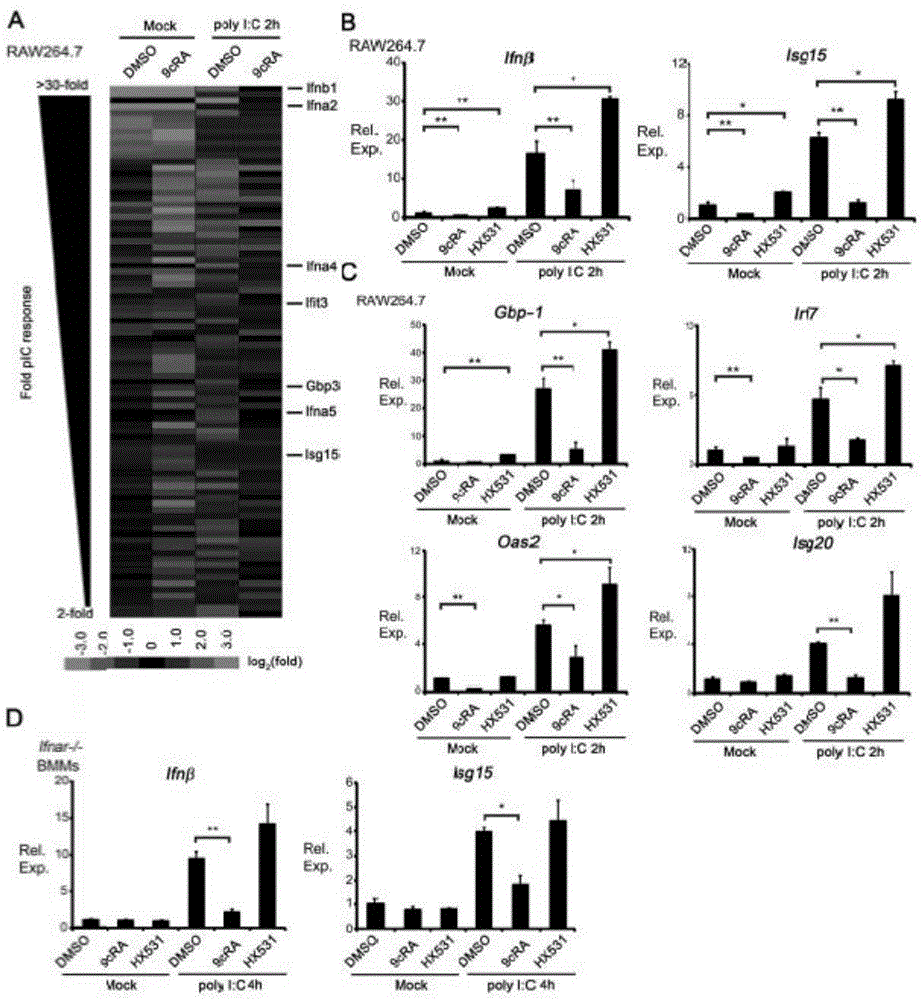Application of RXR to construction of herpes simplex virus type-1 (HSV-1) tolerant model
A technology of herpes simplex virus, HSV-1, applied in the field of biomedicine
- Summary
- Abstract
- Description
- Claims
- Application Information
AI Technical Summary
Problems solved by technology
Method used
Image
Examples
Embodiment 1
[0048] RXR expression regulates host tolerance to herpes simplex virus type 1 (HSV-1) infection:
[0049] Our previous genetic studies have established a novel interferon regulator 3-dependent but interferon-independent mechanism to downregulate RXR expression (Chow et al. 2006). To determine RXR expression levels by different types of virus infection, bone marrow-derived macrophages were infected with herpes simplex virus type 1. The results showed that the expression of RXR was down-regulated after infection with the above viruses (such as figure 1 shown in A). Repression of the RXR gene was not due to changes in the cell state after infection, as the L32 control gene was unchanged (data not shown). Administration of the RNA virus analogue polyI:C and the DNA virus analogue polydA:dT can activate intracellular virus and also significantly inhibit the expression of RXR in bone marrow macrophages. (Such as figure 1 Shown in B) More importantly, it confirms that this suppre...
Embodiment 2
[0053] Ligand activation of RXR inhibits the expression of multiple antiviral genes:
[0054] In order to study how RXR weakens the host immune response and facilitates virus infection, the inventors of the present invention performed gene chip detection on the RXR agonist pretreatment group and macrophage PolyI:C transfection group. The results show that 9 cis retinoic acid can inhibit a variety of Poly1:C-induced genes, including type 1 interferon genes (such as IFN1, IFN2, IFN4, IFN5) Isg15, Ifit3 and Gbp3 (such as image 3 A) Considering that type 1 interferon and its downstream interferon-stimulated gene ISGs play an important role in the host's immune response in antiviral infection, RXR-mediated inhibition of these antiviral genes may be the host's response to viral infection caused by susceptibility. In order to verify the genetic data and prove the hypothesis that RXR is beneficial to virus infection by inhibiting antiviral genes, the inventors pretreated RAW264.7 ce...
Embodiment 4
[0056] RXR inhibits the transcription of interferon by targeting and regulating the downstream RIG-1 and TLR3 signaling pathways:
[0057] In order to further study how RXR inhibits type 1 interferon, the present inventors applied the interferon catalyst luciferase receptor (IFN-luc) and found that the 9-cis retinoic acid-treated group transfected by PolyI:C significantly reduced the interference Activation of the prime promoter. (Such as Figure 4 shown in A). These data suggest that RXR represses interferon transcription.
[0058] The transfected PolyI:C can be recognized by TLR3 and RIG-1, and TLR3 and RIG-1 recruit downstream adapter molecules IPS1 and TRIF, respectively. Both IPS1 and TRIF can promote the phosphorylation of TBK1 kinase and interferon regulatory factor 3, and then the dimer of interferon regulatory factor 3 enters the nucleus to promote interferon transcription (Newton and Dixit2012; Takeuchi and Akira2009, 2010). Co-overexpression of RXR significantly...
PUM
 Login to View More
Login to View More Abstract
Description
Claims
Application Information
 Login to View More
Login to View More - R&D
- Intellectual Property
- Life Sciences
- Materials
- Tech Scout
- Unparalleled Data Quality
- Higher Quality Content
- 60% Fewer Hallucinations
Browse by: Latest US Patents, China's latest patents, Technical Efficacy Thesaurus, Application Domain, Technology Topic, Popular Technical Reports.
© 2025 PatSnap. All rights reserved.Legal|Privacy policy|Modern Slavery Act Transparency Statement|Sitemap|About US| Contact US: help@patsnap.com



